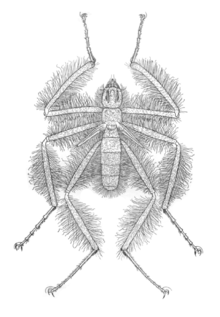| Mormotomyiidae | |
|---|---|

| |
| A drawing of male specimen | |
| Scientific classification | |
| Domain: | Eukaryota |
| Kingdom: | Animalia |
| Phylum: | Arthropoda |
| Class: | Insecta |
| Order: | Diptera |
| Superfamily: | Ephydroidea |
| Family: | Mormotomyiidae |
| Genus: | Mormotomyia |
| Species: | M. hirsuta
|
| Binomial name | |
| Mormotomyia hirsuta Austen, 1936
| |
The family Mormotomyiidae (Diptera: Ephydroidea) contains only one known species, Mormotomyia hirsuta, commonly known as the frightful hairy fly[1] or terrible hairy fly,[2][3] which is found in Kenya. The fly was first described by English entomologist Ernest Edward Austen,[4] and specimens have been collected from one location on a mountain in the Ukasi Hill (Okazzi Hills), in a cleft where a bat roost is located; this may possibly be the most restricted geographic distribution for any fly family. The larvae have been collected from bat guano. Adult flies are believed to feed on bodily secretions of bats. The fly measures about 1 cm long, with hairy legs, and, due to its nonfunctional wings and tiny eyes, looks more like a spider than a fly. Specimens have been collected only three times, in 1933, 1948, and 2010.[5][6] Tested members of the population showed higher levels of genetic variation than would be expected for such a restricted range, suggesting that additional undiscovered populations exist with gene flow occurring between them and the known population in Ukasi Hill.[7][2]
Taxonomy
While the fly was originally thought to belong in the superfamily Sphaeroceroidea, later authorities placed it in Hippoboscoidea, still later work suggested it belonged instead to the Carnoidea, but work in 2011 suggested that its true affiliation is to Ephydroidea.[1]
References
- ^ a b Kirk-Spriggs, A.H., Kotrba, M. & Copeland, R.S. 2011. Further details of the morphology of the enigmatic African fly Mormotomyia hirsuta Austen (Diptera: Mormotomyiidae). African Invertebrates 52 (1): 145-165.[1]
- ^ a b Copeland, R.S., Kirk-Spriggs, A.H., Muteti, S., Booth, W. & Wiegmann, B.M. 2011. Rediscovery of the "terrible hairy fly", Mormotomyia hirsuta Austen (Diptera: Mormotomyiidae), in eastern Kenya, with notes on biology, natural history, and genetic variation of the Ukasi Hill population. African Invertebrates 52 (2): 363-390."Archived copy". Archived from the original on 2011-10-21. Retrieved 2011-11-24.
{{cite web}}: CS1 maint: archived copy as title (link) - ^ "Mormotomyia hirsuta". NCBI taxonomy. Bethesda, MD: National Center for Biotechnology Information. Retrieved 10 January 2018.
Genbank common name: terrible hairy fly
- ^ Austen, E.E. 1936. A remarkable semi-apterous fly (Diptera) found in a cave in East Africa, and representing a new family, genus, and species. Proceedings of the Zoological Society of London (1936): 425–431.
- ^ "Bizarre hairy fly is rediscovered". BBC News. 8 December 2010.
- ^ "World's rarest fly rediscovered". National Museum. 7 December 2010. Archived from the original on 18 July 2011. Retrieved 10 December 2010.
- ^ Meyer, Marc De (1994). "The obscure cave-fly from Kenya". EANHS Bulletin. 24 (2): 21–22.
External links
 Data related to Mormotomyiidae at Wikispecies
Data related to Mormotomyiidae at Wikispecies
